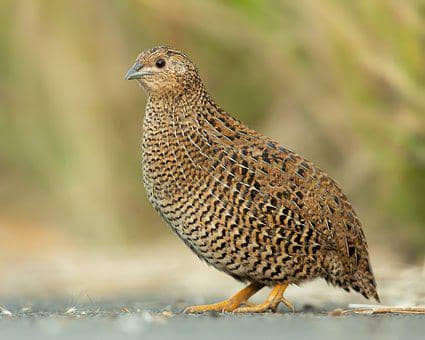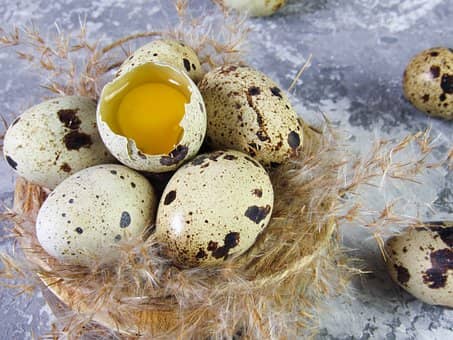Quail farming profit is Rs 30,000 and it is comparatively a less competitive business, therefore, a good opportunity for beginners. The incubation process, hatching, temperature, brooding and more are explained here.
Introduction
You must have heard about poultry farming in which hens and chickens are raised for selling purposes as livestock birds. Its farming is also similar but has different practices and project costs. Let’s first understand what is quail bird. where they are found! later in the post, we will discuss how to start quail farming for profit. Quail is a type of bird small in size and also known as a game bird. They are mostly found in European and North African regions in the entire world.
Quails are not like other birds especially when it comes to creating nests. Usually, birds are known for creating their nests on trees, or along with any shade that has some height from the ground. But these small birds are well known for making their nests on the ground, these birds have short legs and sharp beaks. Quail cultivation is done for its egg and meat. Not only in India but also bird farming in Australia, USA, Nigeria and in the entire world is gaining popularity year by year.
Commercial quail farming business for meat and egg production is done by many countries including Australia, Uganda, the UK etc and the use of commercial cages is done on a large scale for better production and management. Quail eggs and meat are more healthy and tastier in comparison to poultry meat and eggs therefore the demand for quail bird meat and eggs is higher than for chicken meat or eggs.
Bird farming benefits are several, these tiny birds can easily survive in any type of weather and interestingly they can be raised with other birds as well. Moreover, the labour cost for this business is lesser.
Facts and benefits
- Quails are disease resistance
- Birds are low in cost.
- Eggs and meat have a global market.
- Meat has huge International demand.
- Less labour and a small investment are required for farming.
- Commercial cultivation is easy to start with less risk due to less investment and care.
- Birds are small in size so need less space.
- Feed cost is lesser.
- They are fast-growing birds and are able to gain maturity within a week.
- These birds can lay eggs within 44 to 55 days.
- Bird egg hatching time is 16 to 18 days.
- The weight of a mature bird is 150 to 200 grams.
- Egg weight is 7 to 15 grams.
- A female bird starts laying an egg in 45 to 55 days.
- The frequency of birds is one egg per day.
- Bird egg production decreases after 1 year.
- Meat contains low fat and therefore has good demand in the market.
- The meat of quail is tasty and nutritious.
- Quail eggs are of a different colours.
Quail breeds

There are 18 different species available. Three species are most important and used in commercial quail farming. They are common, Japanese quail and King quail.
Common quail
It is a wild variety with 70 to 135 grams weight and 16 to 18 cm height. They usually travel from Europe to Africa. This breed is easy to farm and can easily raise under various circumstances.
Quail Japanese breeds
Female birds are larger. Birds are native to Japan in this breed. Japanese breed is usually brown and grey in colour. They can produce 300 eggs in a year and the average weight of one egg is around 180 grams.
King quail birds
This breed is 12 to 14 cm and weighs 40 grams. These birds are raised as decorative birds and the feathers of these birds are stripped and brown in colour. The male bird’s throat is white, and these birds are found in various colours including white, brown, silver, and black.
Layer quail breeds
Tuxedo, British range, Pharaoh, English white and Manchurian golden are some popular quail breeds. Whereas, broiler breeds of quail are white-breasted and bobwhite.
Incubation process
- The quail incubation period is for 16 to 18 days.
- Eggs are stored at 15 degrees celsius before the incubation period.
- 10-day-old eggs are not incubated.
- The light should be provided for 18 hours for optimum laying.
- Static hatching chambers with static ventilation are used for the incubation process for better production.
- The incubation temperature range should be 38.5 to 39°C.
- The incubation humidity should be 55 to 60% for 14 days. However, humidity can be increased to 70% after the 14th day.
- Eggs need to be turned in every day.
- Eggs are brittle during first 3 days so proper incubation is required without any disturbance.
Quail hatching process

85 to 90% of the fertilized eggs are hatched on the 16th to 18th day.
The deformity rate is estimated at around 10%.
It is recommended not to open the hatching incubator until the 15th day.
One-day-old chicks are 5 to 6 grams in weight.
Chicks should remain in the incubator for 24 hours for drying.
Do not give any feed to chicks during this period.
Bird growing
The bird grows faster and feathers appear on the third day.
It is considered to raise birds of different ages separately.
The quail brooder temperature should be 38 to 40-degree Celsius.
The temperature of the brooder shall be reduced after 3 days by 1°C.
The feeder length is considered 120 cm and the waterer is 40 cm.
Fattening process
Quails are placed in a proper housing system after 3 weeks. They are now raised there for 7 weeks.
Birds of the same age are kept together.
Before the next batch of hatching bedding material from the farm can be replaced.
The mortality rate during fattening is estimated at around 10%.
Birds with good fattening ability are good breeders.
Newspaper and metal trays are used in cages.
Quail slaughter age weight
45 to 50 days old quails with 160 to 180-gram weight are strangulated. Bird skin is then sold on the market.
Floor space requirements
House contains a wider door of 2 meters in height.
House is covered with straw and made up of cement.
Bedding materials are 5 to 10 cm and bedding materials, moss, sawdust or wood shavings are used.
Dimension of the house for brooding 160 birds for 4 weeks: 2m x 1m x 2m.
The above given same dimension can be used for 80 birds.
Prepare a place for the nest for laying eggs by birds.
Keep some branches on the floor with constructed small boxes of 20 x 20 x 15 cm.
There should be a proper laying cycle and for that light should be working properly for 16 to 18 hours continuously in a day.
Solar lights can be used for this kind of house.
Cage system
Farming cages acquire less space, therefore, this farming can be done easily in urban and suburban regions.
Cages are made up of white wood and chicken wire.
Avoid multi-floored cages they may create stress in the birds.
You should place cages on one or two floors for proper air circulation.
To protect the birds from sun, wind and rain kgs should be placed inside a building.
Batten should be preferred for wooden construction to get immediately replaced if found any damage.
The wooden bottom is considered for cages with a horizontal floor 5-degree inclination.
Cover the chicken wire mesh cages with paper to avoid injury.
For small birds, wire mesh spacing should be under 7 mm.
For mature birds, wire spacing can be around 1.5 cm.
Dimension for 80 brooder birds for 4 weeks, 40 laying birds or 20 species is 1 x 0.5 x 0.5 or 2 x 0.5 x 0.5.
Create a sand bath with dimensions 30 x 35 cm.
Feed formula
Maize, Millam and sorghum are considered the main food. Provide clean and fresh water to the quails. Feed them with lettuce, apples, carrots, cooked pasta, papaya, banana, cabbage, rice etc. Clean the feeder box after every meal. Feed for quail is broken wheat, rice bran, sesame cake, kipper fish, broken oyster shell, salt and mineral mix. They need high protein feed in different stages. For protein feed them with insects such as termites, flies, mealworms and larve
Starter feed – 25 to 28%, 1% calcium, 0.5% phosphorus
5-week – ground shell limestone as calcium substitute.
Project report
| Quail farming cost 2000 quail birds Construction cost per square feet = Rs 190 Space required per bird = 0.15 sqft 1 quail chick cost = Rs 10 Chick cost = 2000 birds x Rs 10 = Rs 20,000 Feed consumption per bird = 600 gram Feed cost = 2000 birds x 600 grams = 12 lakh gram And 12 lakh gram = 1200 kg Feed cost per kg = Rs 20 Feed cost = Rs 20 x 1200 kg = 24000 Feed cost = Rs 24000 Electricity bill and other expenses = Rs 10,000 Total cost = Rs 54,000 Quail farming income Selling price = Rs 42 per bird Profit = 2000 birds x Rs 42 = Rs 84,000 Net Profit = farming profit – farming cost Net Profit = Rs 84,000 – Rs 54,000 Net Profit = Rs 30,000 Note – This is the assumption of the quail farming project report and the actual figure may vary according to the location price. Eggs or gunny bag sales are not included above and one can include them as well for more profit. |
Bird farming licence in India
If you are doing bird farming in India then you need a licence for the same. You can consult with the agriculture officer, department or animal husbandry department of your region for a quail farming licence. Your farm should be 5 km near the forest area and you should buy birds from a licenced trader. The farm should have proper fencing.
FAQ
Which animals are included in livestock?
Goats, Cattle, Buffalo, Sheep, Goats, Pigs, Chickens, Ducks, Dogs and Quails etc are considered livestock.
What should be quail incubation temperature and humidity?
The incubation temperature should be around 38.5 to 39°C whereas the incubation humidity should be 55 to 60% for 14 days.
Is quail farming profitable in India?
Yes, it is a profitable business in India. Farmers can earn around Rs 9 to 10 lakh annually from this farming.
What should be the quail brooder temperature?
The temperature should be around 38 to 40°C.
Is a licence necessary for a bird farming business?
Yes, a licence is required to start this business.
Hope you got some information and hopefully, you can start quail farming for profit. Please share this information to help others as well.
Read More